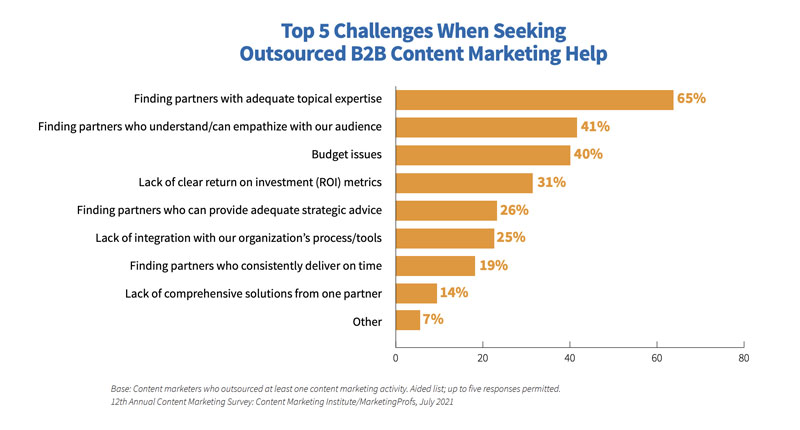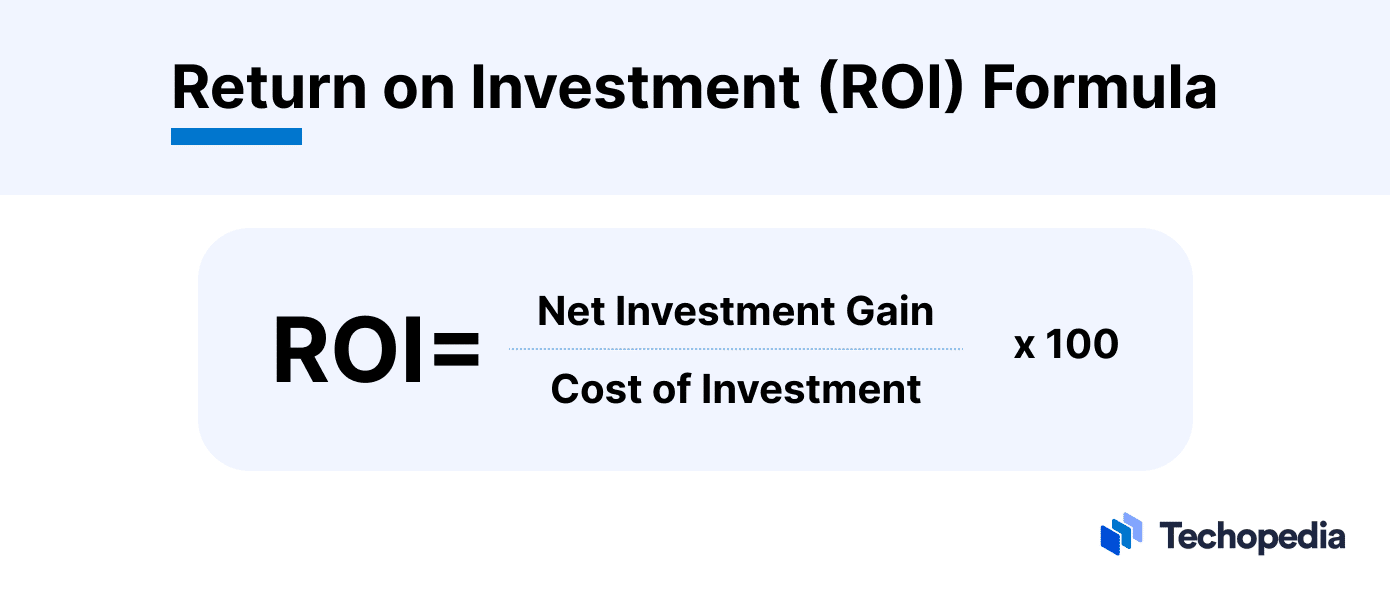One of the hottest topics for any content marketer is the story of ROI. Without proving the return on investment of content marketing, your enterprise team might not get the budget or resources it deserves.
Still, many struggle to connect the dots in content analytics regarding lead acquisition, conversions, and revenue. In fact, the Content Marketing Institute’s annual survey uncovered that content marketing ROI is a top-five challenge, according to 31% of respondents in the B2B space.

Source: CMI
While ROI can be a huge pain point, you have to do it to get funding and attribution for revenue generation. Plus, tracking ROI helps you learn what works and doesn’t so your team can get better.
Learn the right way to start measuring content marketing ROI and the metrics you should be using.
Key Takeaways:
- Measure your overall ROI by dividing your net gain by the cost of your content marketing initiatives.
- Beyond revenue, determine other key performance indicators (KPIs) that show success, including increased leads, higher conversions, greater content volume, and lower production costs.
- To be effective, you must measure success metrics regularly — monthly at the least.
Where You Should Start With Content Marketing ROI
ROI might be the single most important metric in any area of business. It shows how much revenue you gain in comparison with the time, money, and resources you spend on an item or effort.
True, measuring your content marketing ROI eventually involves managing a lot of data. However, the basic calculation remains simple:
Content Marketing ROI = The Value Content Generates / The Costs to Produce It X 100

Source: Techopedia
To illustrate, imagine you have a campaign or quarter of marketing activities that cost $35,000 in time and money. If you can show that the expense yielded $175,000 in revenue, you have a respectable content marketing ROI of 500%.
Sometimes, industry pros specify marketing ROI as ROMI, the return on marketing investment. The formula is similar, except you consider the sales you generated and subtract and divide by your marketing expenditure.

Source: SEObility
Still, that’s only the surface of getting a comprehensive grasp on ROI.
The Right Goals for Content Marketing
Content marketing ROI doesn’t always mean revenue; it’s much deeper than that. Really, it’s about your reputation and connection with your audience.
Buyers consume your content to find out who you are and what you can do for them. Your ultimate goal is to build a long-term relationship that leads to recurring revenue and a high customer lifetime value.
Therefore, different types of content will yield different kinds of metrics that indicate the strength of those relationships. The metrics you use should provide a measurable indication of larger, abstract concepts and initiatives that drive success, such as:
- SEO improvement and traffic generation
- Lead generation and customer retention
- Brand awareness and buyer engagement
- Thought leadership and customer education
- Sales enablement and market expansion
Which ones you focus on depend on your industry, niche, clientele, and past performance. You’ll need to do some testing, but you’ll soon be able to define the KPIs that are true success metrics.
Intelligent Content Marketing Practices and Tools for Building a Healthy ROI
Your first move will always be to set a baseline of your current numbers. From there, you’ll compare everything you do moving forward as you measure and monitor your stats for your content marketing ROI.
Data is essentially gold for content marketers, so always be mining. Collect metrics monthly at the least and compare them to previous timeframes. As you do, it will become easier to measure the ROI of content more accurately and improve it.
Bear in mind that more data means more work if you have to combine it manually. Doing it all without the benefit of automation might give you great insights that are, unfortunately, too late to implement.
To make it easier for your team to deliver these reports, you’ll appreciate a robust content operations platform. Such software aggregates data from multiple sources and provides analytics in one place.
10 Metrics You Need to Track Your Content Marketing ROI
Start by considering the following metrics for content marketing ROI. If you find other valuable metrics, don’t hesitate to adopt them.
1. The Volume of Content You Publish
The rate at which you produce content is critical to calculating its ROI. Your content strategy should define your expected throughput for a month, including formats, the corresponding campaigns, and the distribution channels. Ensure your production schedule aligns with your content calendar.
2. Content Production Costs
How much does it cost to bring a piece of content from ideation to publication to promotion? That’s another vital part of the content marketing ROI equation.
Those costs could include your full-time staff, payments to outsourced creators, technology fees, and other overhead expenses. Try to determine the average expense for each type of content.
For example, infographics and ebooks have more design elements, so factor in the added costs. Use this metric to determine where you can save money on collaboration tools that streamline the content creation process.
3. Website Traffic
One of the easiest metrics to track is traffic to your website. You can find this in Google Analytics. However, not all traffic is equal. Look at the traffic source (e.g., direct, search, social media, third-party sites, etc.) as you’re calculating the ROI of your content marketing.
You also want to look at returning vs. new traffic. Each piece of content will have its own traffic metrics, including views, clicks, and bounce rates.
4. Keyword Rankings
You should concentrate on producing topic-based content and avoid keyword stuffing. Still, keyword rankings have considerable value in the modern world for SEO. Just make sure you’re ranking for the right keywords with quality content that is actually leading viewers to convert.
5. Backlinks
When other sites point to yours as a reference, you boost your credibility and rise higher in search results. It’s also another way for buyers to find you when they’re searching for related content from others.
As with keywords, links must be relevant to have value. More isn’t always better, so keep tracking the kind of traffic and conversions from links to determine how they affect your content marketing ROI.
6. Lead Acquisition Rates
Before you can get a sale, you need to have leads and prospects. If these are low, determine why your content isn’t attracting an audience or convincing them to learn more by providing their contact info.
One of the greatest benefits of content marketing is its ability to generate leads, so always pay attention to this KPI. Then, use the data to plan content that attracts more leads.
7. Conversion Rates
Every piece of content you produce should have a CTA (call to action). Not all of those will be conversion-specific. It depends on where they land in the funnel.
For CTAs that relate to your definition of a conversion (e.g., subscribing to a newsletter, downloading a gated piece of content, requesting a demo), use a tracking code so you know the specific content that led to the conversion.
Tracking conversions helps you measure content marketing ROI and optimize what you publish. If you learn that certain CTAs resonate with audiences, use more of those.
8. Sales
Every business is in business to make money. Content marketing delivers these by consistently attracting and converting buyers. If a lead comes from content marketing and the prospect engages and interacts throughout the buying process, it should get the credit when your company makes a sale.
To determine this, you’ll need the tracking code to determine the conversions, as we noted above. Additionally, leads from content should start as an MQL (marketing-qualified lead). Those are the numbers that will tell you how content contributes to revenue.
9. Social Media Engagement
Engagement on social media is a big deal for content marketing ROI. It’s not necessarily revenue, but it is a place where buyers discover products, interact with brands, and check their credibility.
If you create content that gets shares, likes, and comments, you’re doing a lot right! Social media engagement raises your brand’s visibility and can indicate trust.
10. Email Open and Click Rates
Email marketing remains one of the lowest-cost marketing efforts with the best ROI. Still, getting it right takes persistent effort. Everyone gets a deluge of messages to their inboxes, so you need to be sure your subject lines and content are getting opens and clicks that convert.
Measure Content Marketing ROI Like a Boss
Calculating ROI demonstrates your team’s value and gives you the data you need to sustain success. To measure your content marketing ROI like the boss you are, you need a tool that makes it easy.
DivvyHQ does that with integrated content analytics that are also accessible. See how it works by requesting a demo today.

